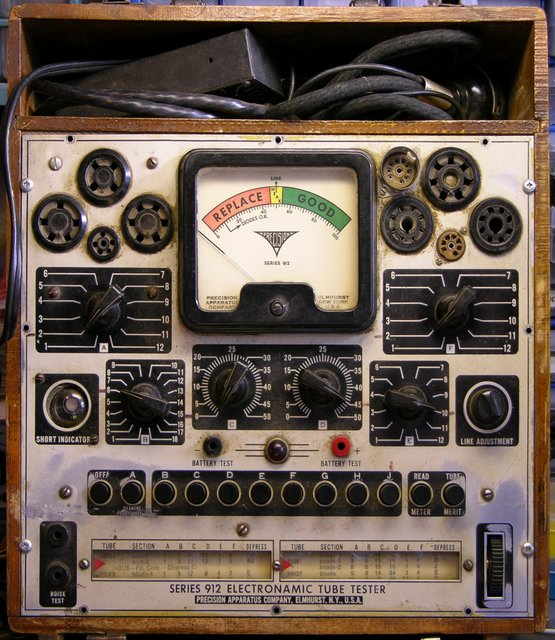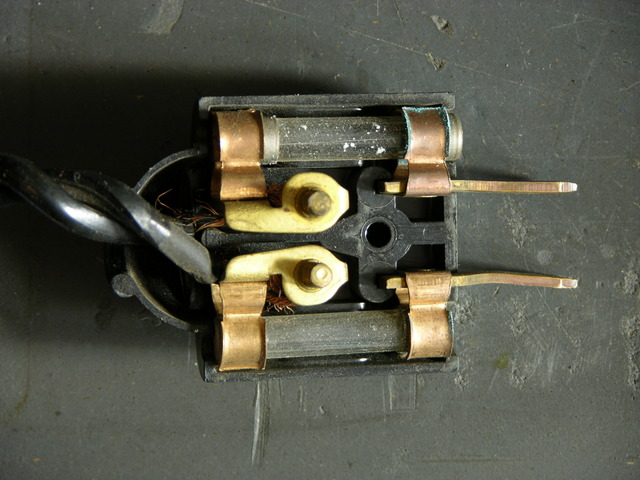I found it up in the garage attic, where I suspected it would be. It’s a Precision Series 912 Electronamic Tube Tester from my uncle’s auction.
I found a manual for it online at http://www.geocities.com/precision_testers@sbcglobal.net/. It’s a scan and occasionally a bit hard to read, so I’ve rekeyed the four pages of text and posted it here. The last page of the original is a schematic showing that the tester comprises a many-tapped transformer and a bunch of selector switches to different socket pins.
Between the instructions and the schematic, I’ve come to the conclusion that this tester is pretty much a filament continuity tester, and little more. What kind of tester would I need if I wanted to test tubes quantitatively to put together matched pairs? Pointers to eBay auctions for <= $30 welcome.
I was intrigued by the power plug:
It’s not polarized, and both leads are fused. Today we’d think of that as a great way to inadvertently open the neutral connection and make the whole device hot, but I suppose it made sense at the time.


That plug is rather interesting. While it is possible that the fuse in the neutral leg could blow, That shouldn’t cause a major problem unless the transformer primary is connected to the case, which it doesn’t appear to be (Yes, there’s the issue with a shorted transformer [1], and there’s the issue of leakage [2].). On the other hand, since, in that era before polarized plugs were available, you couldn’t tell which side of the line was connected to the hot and which to the neutral, it was safer to fuse both sides.
[1] Then, again, since quite a bit of equipment from that era was designed so that you could have a hot chassis, maybe it wasn’t such a big issue. People tended to be much more careful about things like that back then (and, the ones that weren’t were quickly weeded out of the gene pool).
[2] I have had some personal experience with test equipment which capacitively coupled the chassis to both sides of the AC line. That basically meant that the chassis was floating at about 60 Volts with respect to either side of the line. And, with .1 uF capacitors being used for this, you could get quite a jolt.
As for that testing being a filament/heater continuity tester, I’ll disagree with that statement. According to my reading of the manual, it checks for a couple of common failure modes. Obviously, the filament/heater continuity is tested, but it also checks for shorted elements. It wasn’t too uncommon for the various grid wires, being exceptionally small, to occasionally short. This was especially true if the vacuum tube had been subjected to mechanical shocks (e.g., mobile applications, or just bumping the equipment it was in really hard). Another test that the tester performs is that of cathode emission.
One of the common failure modes of vacuum tubes is that the cathode emission (of electrons) falls off over time. One of the reasons for this is that for tubes using Thoriated Tungsten cathodes/filaments [3], the tiny amount of Thorium on the surface of the filament evaporates off. This leaves only the Tungsten, and Tungsten emits electrons much poorer than Thorium. For more modern tubes, they used a Rare Earth Oxide coating on the cathode, and, over time (or due to abuse, such as running the tube’s heater at above it’s recommended voltage, which causes the cathode to run at an excessively high temperature) the Oxide coating can be damaged/destroyed. This causes the electron emission to fall off quite dramatically, altering the tube’s characteristics.
[3] If you’ll look at the evolution of tubes, the earliest tubes used pure Tungsten filaments, which were required to be operated at a white hot temperature in order to get enough electron emission to function [4] (I’m discounting the even earlier Carbon thread tubes, since these were never mass produced, and were mostly labratory curiosity items.). Later tubes switched to a Thoriated Tungsten filament, which was only required to operate at red heat temperatures to ensure enough electron emission [5]. The most recent tubes use a Rare Earth Oxide coating, which only requires that the cathode be operated at a very dull red temperature [6].
[4] Typical tube types for this were the 01 tubes.
[5] Typical tube types for this were the 01A tubes, although some transmitting type tubes still use Thoriated Tungsten.
[6] Most “modern” receiving type tubes were of this type.
Yet another failure mode was one called “Cathode poisoning”. This mainly affected tubes where remained in a cut-off condition for long periods of time, such as some of the tubes used in the early electronic computers. The cathode emission would drop dramatically, despite the tube not having been abused.
Thus, this tester appears to check for these common failure modes.
There are, of course, different types of testers. One of the more advanced testers would be a dynamic transconductance tester (which measures the change in plate current with the change in grid voltage). However, it is rare for the transconductance of a tube to change after it’s been manufactured. Such a dynamic transconductance tester may be useful, though, for comparing different tubes (of the same type) in order to closely match the characteristics for a pair of them (e.g., matched/balanced tube pairs). However, most people don’t need this much information.
Dave
If it’s not polarized, you’d need a fuse in each leg – either leg could be hot at any time depending on how it was plugged in.
I just finished refreshing a Hallicrafters S-38B, which was wired SPECIFICALLY so that any way you plug the thing in the chassis could be hot (either hot with the switch OFF or hot with the switch ON). Only 4 or 5 tiny rubber and plastic bits keep the outer case from being hot (shudder).
I’ve rewired it to be safe (power on OR off) and I polarized the plug. Good luck with your tube testing. I’m still too cheap to pay shipping on one via eBay… *sigh*. And yes, you need a gas and leakage testor. Swell link here (although I abhor the ‘Idiot’s Guide’ nomenclature…)
http://www.tone-lizard.com/Tube_Testers.html
Mike
Something about old test equipment encased in wood…I don’t know…kinda makes you want to say…”Nice, real nice…”
Of course the question begs to be asked, “Does it still work?”
Dave, Mike — yes, fusing both legs of a non-polarized plug makes sense. It’s just interesting to see the progression from double-fused plugs to polarized plugs to double-insulated non-polarized power on modern handheld power tools.
Mike — thanks for the Tone Lizard link. I still don’t “get” tubes, but at least it gives me a bit of an idea what to look for in a tester. Plus the guy is a hoot.
James — yeah, I love the old gear in wood cases, bakelite cases, and anything in that hideous test-equipment blue. I have a small stash of (very) dead equipment that I’m saving to rebuild something new into the cases.
As to whether it works, I don’t know. The power cord is brittle and cracked enough that I’d replace it before trying. I’m also nervous about the capacitors inside. Having come from my uncle, I suspect it worked when he stopped using it, but I can’t vouch for it right now.
Keith,
I might be interested in the K1 programmer – if it is for sale…(?)
Joel, I’m sorry but I’m not sure what you’re referring to.
Wow, this article brought back some memories. I think that exact model of tube tester was used in a TV repair shop that I hung out at as a teen 40+ years ago.
About 95% of repairs involved replacing a tube.
The boss would sometimes “rejuvenate” tubes by goosing up the heater voltage (and perhaps the plate current?) for a couple minutes. Anyone know how that was supposed to help?
Nice web site!
I was wondering if you knew what the value of the Series 912 electronamic tube tester is? I have one and am not wanting to keep it. I have no use for it, and would like to sell it. Thank you.
Rachel, I’m sorry, but I really don’t know. Perhaps readers will chime in.
If I really wanted to know the market value, I’d save an eBay search for it, then wait (potentially a long time) to see how much it sold for.
You might also get better answers on an amateur radio equipment forum?
I have a series 912 that I am researching to see what value it may have, was hoping you might be able to help out. I have not seen much on ebay other than one for parts, mine is working, the case is a bit beat up, but the inside is in real nice condition. Maybe someone has run across something since Dec. 2010
Thanks